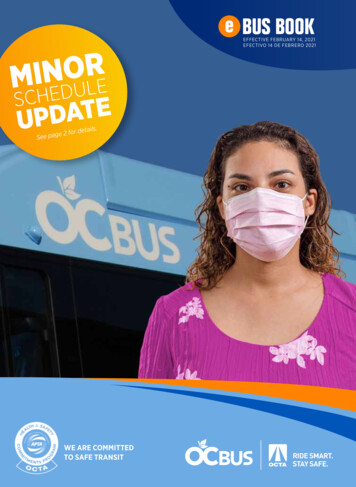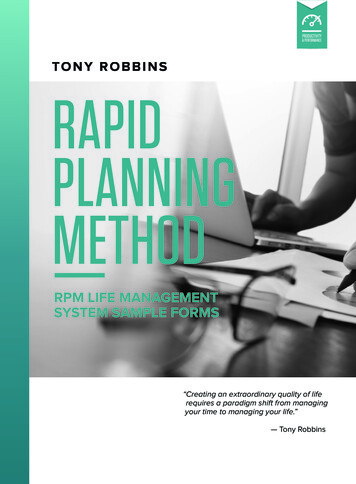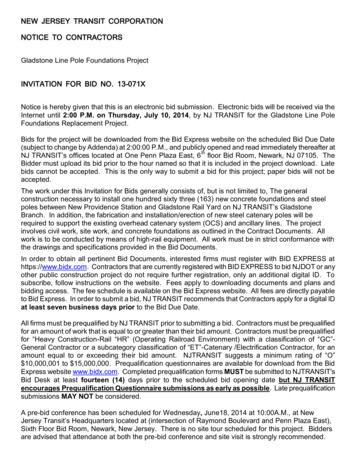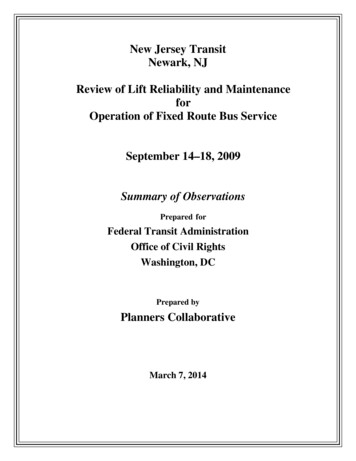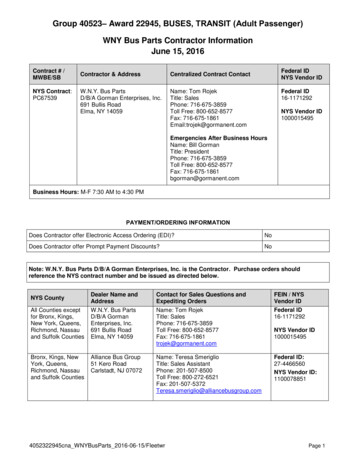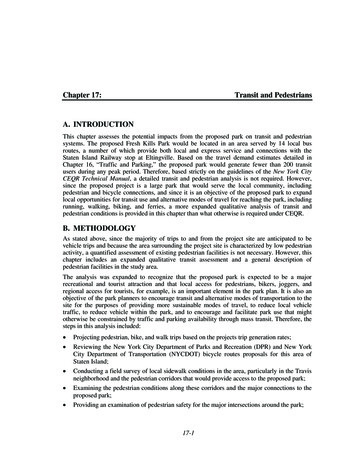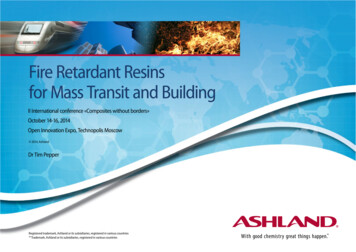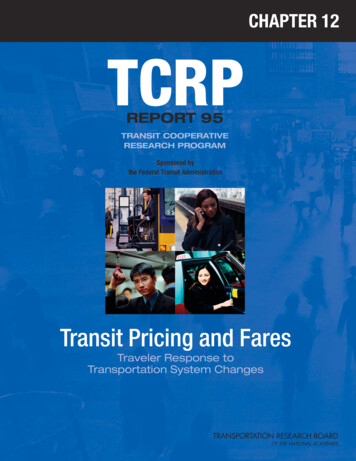
Transcription
The Bus Rapid Transit Planning Guide, 4th EditionVolume IV: Business PlanningNovember, 2018Dr. Walter HookBRT Planning InternationalBRT Planning International, 2018
CH. 12: Institutional PlanningHow should a BRT project be managed? BRT project office should have its own physicaloffices with the project identity Office needs to be properly equipped; Key staff needs to be dedicated full-time withoutother administrative responsibilities; A budget sufficient to hire the experts needed Make sure the experts have worked on successfulprojectsBRT Planning International, 2018
CH. 12: Institutional PlanningFrom where should the initial project be managed?It doesn’t seem to matter as much as Host of Initial BRT Project OfficeTransMilenio, BogotaGBRT, GuangzhouBRT, CuritibaGuadalajara, MexicoPereira, ColombiaJan Marg, AhmedabadRea Vaya, JohannesburgLeon, MexicoGuayaquil, EcuadorQuito, EcuadorMetrobus, Mexico CityHealthLine, ClevelandLanzhou, BRTTransantiagoTransJakarta, JakartaLA Metro Orange LineCape Town MyCiTiPittsburgh MLK buswaySan Francisco (no BRT yet)Dar es Salaam DART (2016)Lagos buswaySpecial project officedirectly under Mayor or MunicipalPre-existingMunicipalTransport Dept TransitCommissionerPlanning StaffAuthorityXSpecial projectMunicipalState orPlanning office office under theNationalPlanningProvincialof RegionalgovernmentOffice or Body Transport Dept AuthorityXXXXXXXXXXXXXXSpecial Project OfficeDevelopment under MunicipalBank Project Construction/PublicWorksOfficeXXXXXXGold Standard BRTSilver Standard BRTBronze Standard BRTBasic BRT or BelowBRT Planning International, 2018
CH. 12: Institutional PlanningAdministrative StructureCentral Corridor BRT Project ManagementI-ACTUndersecretaryLontokRobert Siy(Consultant)GC Kim(Consultant)Zhu XianyuanITDPCep GarciaBRTPlanMichael SalalimaRemiITDP ChinaAsst. Sec Reyes(TrafficManagement)LTFRBLTOAsst.Sec Fabillar(NPMO Head)All the BRT projects in thePhilippines were managed byone consultant and oneUndersecretary of the NationalDOTNaturally, they were quite busy Cebu BRT PIUHeadMora, CentralCorridor BRTCoordinatorRoxas BRTCorridorQuezon Ave BRTCoordinatorC5 BRTCoordinator6 NPMO Staff(incl.administrative)BRT Planning International, 2018
CH. 12: Institutional PlanningDesigning a great BRT is administrativelycomplex BRT Planning International, 2018
CH. 12: Institutional PlanningThe BRT Authority Needs to have 1, The administrative power (and political support) to compelcoordinated action across a number of government departments2. No conflicts of interest.3. The ability to hire competent staff, or use outside consultants4. The weaker the administrative capacity, the less sophisticated theproject needs to be and the fewer the number of contracts theadministration will be able to manage effectively.5. Financial ring-fencing to protect technocratic decision-making.The authority should function from fare revenue and, if necessary,dedicated funding streamsBRT Planning International, 2018
CH. 12: Institutional PlanningRea Vaya BRT Project Office Initially hadno control over fare collection contract(JRA), operational control (JRA),roadworks (JDA & JRA), or stationservices (MTC)BRT Planning International, 2018
CH. 12: Institutional PlanningWho should manage the BRT operations?Developed CountriesInstitutions Managing Bus and BRT Systems, Select racted Public Bus Rail/Metro (excludingBus Authority Authority BRTCompany Company Metro rail)TransportContractedTransportAuthority (All TransitTransit Service DepartmentAuthority Providertransport)In HouseDeveloped CountriesRouen, France (TransDev)Paris Mobilien, Ile de France (RATP)Brisbane, Australia (TransitLink)Amsterdam R-Net (rating pending)Nagoya busway (rating pending)Hartford, CT (CT Fastrak)HealthLine, Cleveland (RTC)Cambridgeshire , EnglandNantes, France (Semitans)LA Metro (Orange Line)Las Vegas (RTCSV)Ottawa, Canada (OC Transpo)Pittsburgh MLK (Port Authority)London (busways only)San Francisco (no BRT yet)XXXXXXXXXXXXXXXXXBRT Planning International, 2018
CH. 12: Institutional PlanningWho should manage the BRT system? DevelopingInstitutions Managing Bus and BRT Systems, Select tyContracted Public Bus Rail/Metro (excludingBRTCompany Company Metro rail)Bus Authority Authority BRTDeveloping CountriesTransMilenio, BogotaXMedellin, ColombiaGBRT, GuangzhouGuadalajara, MexicoLima (Protransporte)Rio de Janeiro (TransCarioca, TransOeste)Curitiba (URBS)XBelo Horizonte (BHTrans)Dar es Salaam (2016)Pereira, Colombia (Megabus)Guayaquil, Ecuador (Metrovia)Cali, Colombia (Mio)Sao Paulo, Brazil (SP Trans)XAhmedabad (Jan Marg SPV)Johannesburg (Rea Vaya)Monterrey, MXMexico City (Metrobus)Estado de Mexico (Mexibus)Jakarta, ID (TransJakarta)Leon, MX (rating pending)Caracas, VZLanzhou, BRTBeijing, ChinaJinan, ChinaSantiago, Chile (Transantiago)Puebla, MXCape Town BRTLagos busway (Not portAuthority (All TransitTransit Service Departmenttransport)In HouseAuthority ProviderXXXXBRT Planning International, 2018
CH. 13: Business PlanningGoals: Maximize the quality of the service overthe long term; Minimize the cost of the service over thelong term; Maximize the level of private sectorinvestment over the long term; Maximize the public benefit from thepublic investmentBRT Planning International, 2018
CH. 12: Business PlanningGovernment needs to make fundamentaldecisionsDecision #1: Public or Private? Bus operations Bus procurement Fare collection equipment andoperations Operational control system equipmentand operationsBRT Planning International, 2018
CH. 13: Business PlanningMost countries going private, except the US Private Versus Public OperationsSystemRioBogotaMexico CityPereiraCaliJohannesburgSantiagoCuritibaSao PauloAhmedabadMalmo/KristianstadQuito Lines 2 & 3GuangzhouCape TownJakartaLanzhouClevelandQuito TrolebusBus procurementPrivatePrivate2/3 cPublicBus OperationsPrivatePrivate2/3 licPublicFare ublicPublicPublicPublicControl cPublicPublicPublicBRT Planning International, 2018
CH. 13: Business PlanningWould transit be more competitive with FHVcompanies is there was more private sectorinvolvement in the sector?Developed CountryBus OperationsBRT SystemRouen, France (TransDev)PrivateParis Mobilien, Ile de France (RATPPrivateBrisbane, Australia (TransitLink) PublicAmsterdam R-Net (rating pending) PrivateHealthLine, Cleveland (RTC)PublicCambridgeshire , EnglandPrivateNantes, France (Semitans)Public*LA Metro (Orange Line)PublicLas Vegas (RTCSV)PrivateOttawa, Canada (OC Transpo)PublicPittsburgh MLK (Port Authority) PublicNagoya busway (not yet rated)PublicFare Public*PublicPrivatePublicPublicPublicBRT Planning International, 2018
CH. 13: Business PlanningContract types: How is the operator paid Profit sharing gross cost Gross cost Net costHow is the market defined Route contract Zone-based contract Service contract (no specified route or zone)How is the market entry regulated No regulation Fleet quality regulation only Zone or route exclusivity System-level exclusivityBRT Planning International, 2018
CH. 13: Business PlanningGeneral principal1. You need to attract investors willing to take arisk on your market.2. Developing countries are riskier investmentclimates for foreign firms so investors arelikely to be investors already comfortable withthat country3. The riskier the market, the more the contracthas to mitigate the risk.4. Market risk translates into higher operatingcostsBRT Planning International, 2018
CH. 13: Business PlanningNet Cost: The bus company collects the revenue directly from passengers. Usually they use conductors Operator sets the frequency All revenue is paid per passengerImpact Fully exposed to demand risk (insulates govt from demandrisk) Can create dangerous competition for passengers curb-sideunless market is regulated. Companies profits vary a lot between routes and will change ifgovt adds competing services Increases risk of operators waiting until full of passengers todepart and picking up passengers at unregulated stops Can reduce the risk of fare evasion leading to subsidiesBRT Planning International, 2018
CH. 13: Business PlanningGross Cost:The government or their contractor collects the fare revenue, not thebus operator.The operator is paid based based on a formula (per km, per bus hour,etc)The formula may include some demand risk but it will be less than inNet Cost removes demand risk,Removes dangerous competition for passengers curb-side.Reduces unscheduled stopsReduces risk of shortage of services off peak and less popularareasincreases risk of operators skipping passengersincreases risk of driving more kilometers than neededIncreases risk of fare evasion and need for subsidiesThe more closely the fee resembles the operators cost structure, theless you are paying a risk premium.BRT Planning International, 2018
CH. 13: Business PlanningBRT Operator Payment TypeDeveloping CountryBRT SystemPayment MethodTransMilenio, BogotaMixed Km and PassengerGBRT, GuangzhouBus KilometerLima (Protransporte)Bus KilometerCuritiba (URBS)Bus KilometerBelo Horizonte (BH Trans)PassengersDar es SalaamMixed Km and PassengerRio de Janeiro (TransCarioca)PassengersPereira, Colombia (Megabus)Mixed Km and PassengerAhmedabad (Jan Marg SPV)Bus KilometerCali, Colombia (Mio)Mixed Km and PassengerJohannesburg (Rea Vaya)Bus KilometerMexico City (Metrobus)Bus Kilometer, Fixed CostState of Mexico (Mexibus)PassengersLeon, MX (Optibus)PassengersMonterrey, MXPassengersGuayaquil, EcuadorBus KilometerCape Town BRTKm, Fleet, Labor, Fixed CostSao Paulo, Brazil (SP Trans)Bus KilometerQuito EcoViaPassengersPuebla, MXPassengersTranSantiagoBus KilometersTransJakartaBus KilometersDelhi HCBSPassengersDeveloped CountryRouen, France (TransDev)PassengersBrisbaneMixed Km and PassengerParis Mobilien, Ile de FranceBus KilometersCambridgeshire , EnglandPassengersNantes, France (Semitans)Bus KilometersLas Vegas (RTCSV)Bus KilometersAmsterdam R-Net (not yet rated)PassengersBRT Planning International, 2018
CH. 13: Business PlanningProfit Sharing: 100% of the system’s revenues are redistributed to allthe system operators (bus operators, fare collector, BRTAuthority) Operators are paid based on fee per kilometer or amore complex formula. The fee per kilometer is fixed and escalated withindexed price increases If demand increases, more kilometers are programmedand the system as a whole becomes more profitable. Operators are partially exposed to demand risk whilethe problems with fee per passenger are avoided.Profit sharing with a mixed payment formula is bestpractice, but still requires fare enforcement from theBRT Planning International, 2018
CH. 13: Business PlanningGeographically Defined Licenses:Route licenses: One company, one route Very difficult to change the routingstructure Big fight over any new inter-corridor route Unless the route licenses are auctionedoff, there are almost always ‘informal’mechanisms for awarding the best routes Hard to sustain with all door boardingZone-based licenses Service flexibility within the zone but notbetween zones. Routes end up not crossingBRT Planning International, 2018
CH. 13: Business PlanningProblem with route licensesor route concessions:Introducing inter-corridorroutes is hardKotaKota StationStationExamples:JakartaMexico CityTransantiago Pre-2011HarmoniHarmoniMonasMonasBunderanBunderan SenayanSenayanBlokBlok MMBRT Planning International, 2018
CH. 13: Business PlanningProblem with zone-basedcontracts:Introducing interzonal BRTservices is hard.Examples:Transantiago Pre-2011TransMilenio SITP2014Sao Paulo,CuritibaBRT Planning International, 2018
CH. 13: Business PlanningNon-Geographically defined contractsService Contract: Operators are awarded a minimum number ofkilometers These kilometers can be operated anywhere thetransit authority asks. Very easy to make service changes and add newservices without renegotiating the contractBRT Planning International, 2018
CH. 13: Business PlanningHow Regulated is Market Entry? BRT does not do well with old, poorlymaintained buses. If one breaks down,the corridor backs up. Access to the BRT is best restricted to: Quality vehicles Quality companies Companies under contract to a singleauthority More than one operator on a corridormakes possible competition within themarketBRT Planning International, 2018
CH. 13: Business PlanningHow Regulated is Market Entry?Poorly regulatedbuses using theDelhi HighCapacity BusServicecontributed tonegative publicreaction and itseventual removalBRT Planning International, 2018
CH. 13: Business PlanningBRT Operating Contract TypeContract TypeDeveloping CountryTransMilenio, BogotaProfit sharingGBRT, GuangzhouProfit sharingLima (Protransporte)Profit sharingCuritiba (URBS)Area contract (gross cost)Belo Horizonte (BH Trans)Area contract (net cost)Rio de Janeiro (TransCarioca)Area contract (net cost)Pereira, Colombia (Megabus)Profit sharingAhmedabad (Jan Marg SPV)Service contract (gross cost)Cali, Colombia (Mio)Profit sharingJohannesburg (Rea Vaya)Service contract (gross cost)Mexico City (Metrobus)Route contract (gross cost)State of Mexico (Mexibus)Design-Build-Operate formsLeon, MX (Optibus)Area contract (net cost)Monterrey, MXDesign-Build-Operate formsGuayaquil, EcuadorProfit sharingSao Paulo, Brazil (SP Trans)Area contract (gross cost)
The Bus Rapid Transit Planning Guide, 4th Edition. Volume IV: Business Planning. BRT Planning International, 2018. November, 2018 . Dr. Walter Hook. BRT Planning International. CH. 12: Institutional Planning . BRT Planning International, 2018. How should a BRT project be managed? BRT project office should have its own physical offices with the project identity Office needs to be .


